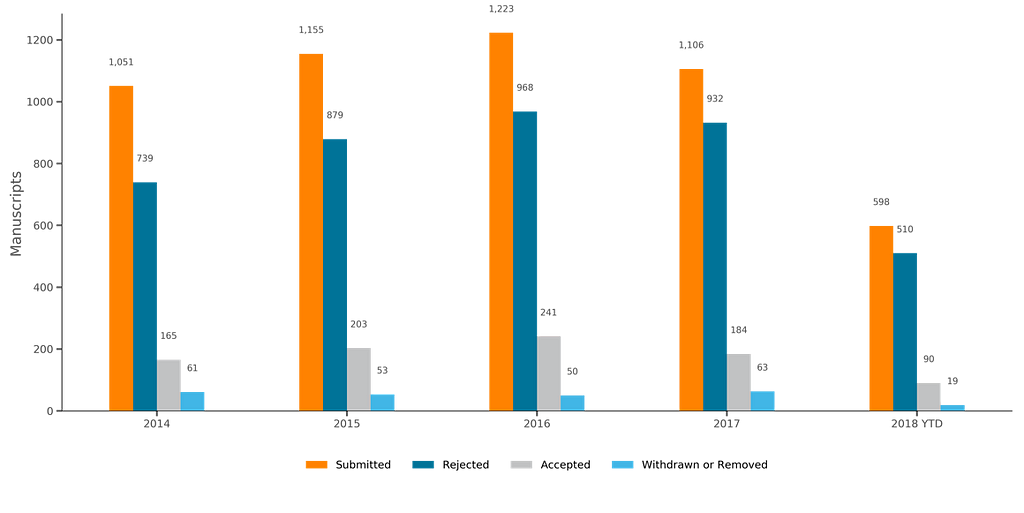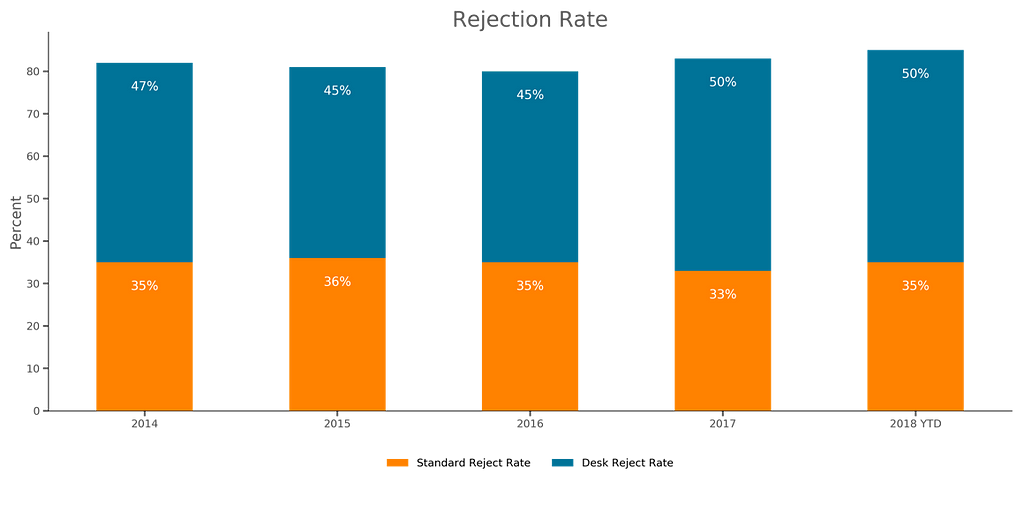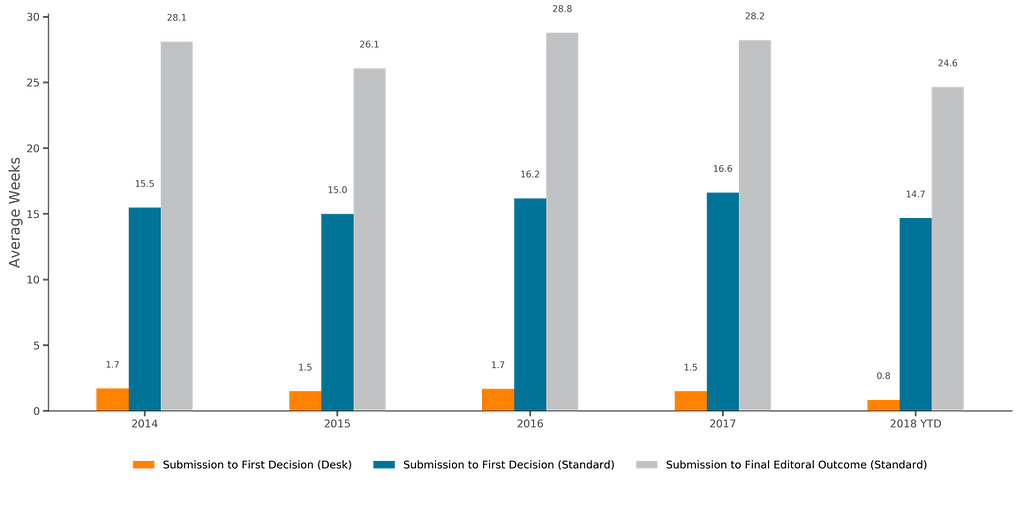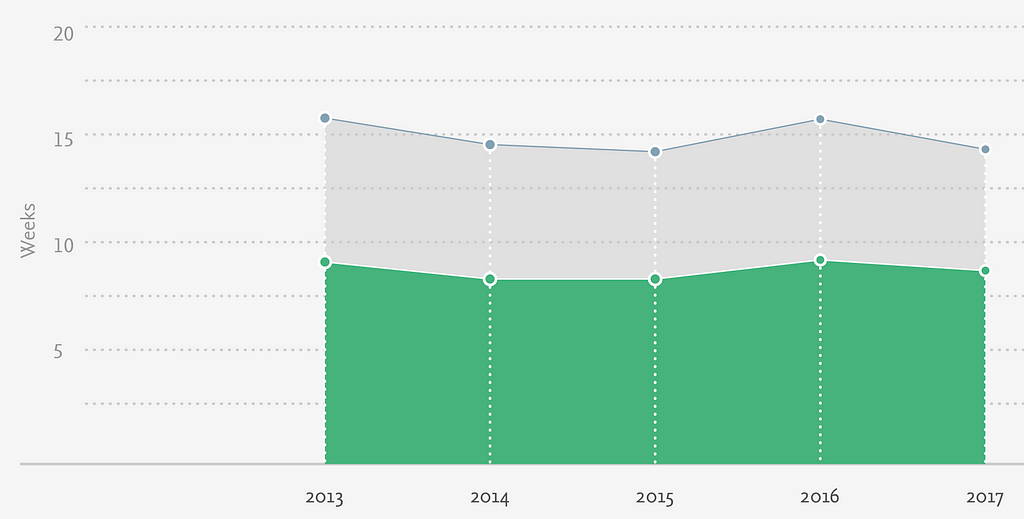
Bibliometrics — we all hate them, and yet everybody seems to be talking about them.
In a Twitter discussion end of June, Vahid Garousi has (inspired by a Medium blog post by CSIndexbr, a Brazilian computer science index) asked about acceptance rates for JSS:
@mtov It would be nice if our SE journal report their acceptance rates too (let's say in a yearly basis), like conferences...!
It should be noted that current bibliometric data can always be found on this great site maintained by Elsevier.
However, as one of our goals is to increase transparency in the publication process, we want to oblige to Vahid’s request and provide some more detailed data about acceptance rates at the Journal of Systems and Software in this blog post. All data is as of July 8th, 2018.
How many submissions does JSS receive?
If there is one thing you should remember for JSS, it’s that we receive many submissions. To be exact: since 2014, JSS has received between 1051 and 1223 (!) manuscripts per year, and accepted between 165 and 241 of them.
This makes our acceptance rate vary between 17% and 19% (not counting the currently running year).
Interestingly, in 2017, the number of submissions was going down slightly, and so was the number of accepted papers. For 2018 it is still a bit early to tell, but it looks like the number of submissions will increase slightly in comparison to 2017.

To cope with this pretty overwhelming submission load, JSS uses a 71-persons strong editorial board, including two Editors-in-Chief, and 27 (senior or regular) associate editors.
JSS acceptance rate in details
For journals, the acceptance rate (or, conversely, the rejection rate) consists of two separate components. Some papers are desk-rejected, that is, rejected by the Editors-in-Chief before even being sent to peer review. Other papers are rejected after peer review.
As we note above, JSS has had a fairly consistent overall rejection rate hovering around 82% for years (which trivially translates to an acceptance rate of about 18%, give or take). The larger part of these (between 45% and 50% of all submissions) are desk rejected. In the first half of 2018 the rate went up to about 85%. One thing is for sure: it’s not easy getting published in JSS.

How long does JSS take to make decisions?
An often-discussed aspect of journal reviewing is how long it takes between manuscript submission until authors learn about a decision. This is especially true for a journal which gets as many submissions as JSS.
Here, three different time frames are of relevance: (1) the time until an Editor-in-Chief makes a decision of whether to desk reject, (2) the time until the first review round is completed, and (3) the time until a final editorial decision (reject or accept) is made.
JSS has traditionally taken about 1.5 weeks to make a first editorial decision, a little over 16 weeks for the first decision, and a little over 28 weeks (on average) until review is completed. Once a decision is made, things typically move quickly — the average article is online less than a week after a final camera-ready version has been sent in by the authors.

From Elsevier’s bibliometrics site we can also learn that the time for reviewers to make a decision varies between 10 and 16 weeks. More info can be found here.

We want to note that our Editors-in-Chief are working hard on lowering these numbers, and successfully so — for 2018, all three metrics are so far decreasing quite a bit in comparison to between 2014 and 2017.
We hope that you found these statistical JSS tidbits interesting and helpful for your decision making, and hope that we can count on you to further increase our already staggering submission numbers.
If you wish to reach out to us with comments regarding this data (or anything else, JSS-related), please tweet at us at @JSSoftware or use the comment field below this article.
<hr><p>JSS By The Numbers — Mid 2018 Edition was originally published in JSS Editor’s Selection on Medium, where people are continuing the conversation by highlighting and responding to this story.</p>